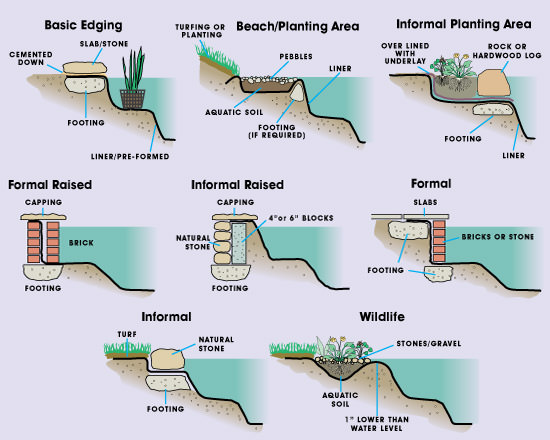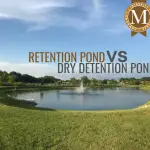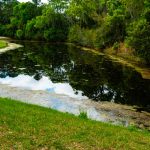To install a pond liner, first, you need to dig out the pond area in the desired shape and depth. Then, carefully place the liner inside the hole, ensuring it is smooth and wrinkle-free.
Choosing The Right Pond Liner
Considerations For Pond Liner Material
When selecting a pond liner material, consider factors like durability, flexibility, and resistance to UV rays.
- EPDM pond liners are popular for their longevity and UV resistance.
- PVC pond liners are cost-effective but may degrade over time.
- HDPE pond liners offer high puncture resistance, ideal for rocky terrains.
Size And Shape Considerations
Ensure the pond liner size accommodates the pond’s dimensions with ample overhang for securing it in place.
- Measure the pond carefully to determine the necessary dimensions for the liner.
- Choose a pond liner shape that fits snugly into the pond without excessive folding or stretching.
Preparing The Pond Site
Prepare your pond site for a successful installation by ensuring the area is clear of debris, leveled, and compacted. Outline the shape and size before laying the pond liner securely to prevent leaks and ensure durability.
Clearing The Area
First, remove any debris such as rocks, roots, and weeds from the pond location.
Leveling The Ground
Next, ensure the ground is level by using a shovel and a level tool.
Laying The Pond Liner
Now that you have prepared the ground for your pond and have checked for any sharp objects or objects that could damage the liner, it’s time to lay the pond liner. This step is crucial in ensuring that your pond remains leak-proof and serves its purpose effectively. In this section, we will discuss the importance of ensuring proper placement and securing the liner.
Ensuring Proper Placement
Before laying the pond liner, make sure the excavated hole is the right size and shape for your desired pond design. Measure and double-check the dimensions, ensuring that the hole is deep enough to accommodate the liner with some excess for folding and securing the edges. This extra allowance will prevent any water from escaping and keep your pond in optimal condition.
| Steps for Proper Placement |
|---|
| 1. Carefully unfold the pond liner and place it into the excavated hole. |
| 2. Smooth out any wrinkles, ensuring the liner lies flat on the ground surface. |
| 3. Gently push the liner into corners and curves of the hole, allowing it to conform to the shape of your pond design. |
Securing The Liner
Securing the liner is essential to prevent any shifting or movement, as this could lead to leaks and potential damage to your pond. Follow these steps to properly secure the liner:
- Dig a small trench around the edges of the pond, approximately six inches deep and four inches wide.
- Fold the excess liner over the edge of the trench, creating a neat finish.
- Hold the liner firmly in place and backfill the trench with soil, compacting it as you go.
- Ensure the liner is taut and free from any folds or creases that could hinder its performance.
By securing the liner in this manner, you provide stability and minimize the risk of water escaping or debris entering your pond. With proper placement and secure fastening, your pond liner will serve its purpose effectively for years to come.

Credit: www.youtube.com
Adding Water And Final Touches
As you approach the final stages of installing your pond liner, it’s time to add water and put those finishing touches in place. This is an exciting moment as your vision starts to come to life, and you see your hard work pay off. The steps to filling the pond, trimming excess liner, and landscaping around the pond are crucial to ensuring the longevity and visual appeal of your pond.
Filling The Pond
Once the pond liner is securely in place, it’s time to fill it with water. For this step, use a garden hose and start filling the pond slowly. It is important to fill the pond partially and then allow the liner to settle and adjust to the weight of the water. Repeat this process until the pond is filled to the desired level. Be cautious not to overfill, as it may cause the liner to shift or tear.
Trimming Excess Liner And Landscaping
After the pond is filled, inspect the edges to see if there is any excess liner protruding. Use a pair of sharp scissors to carefully trim away the excess liner, ensuring to leave a slight overlap to prevent any water seepage. Once the liner is trimmed, you can start the landscaping process around the pond. This often includes arranging rocks or pebbles around the edges, adding aquatic plants, and creating a serene atmosphere to enhance the pond’s beauty.
Maintaining Your Pond
Installing a pond liner is a critical step in maintaining your pond. Begin by preparing the area, removing any debris, and carefully measuring the space. Once the liner is in place, securely anchor it with rocks or soil to prevent shifting.
Regularly inspect the liner to ensure it remains intact and functional.
Maintaining Your Pond Maintaining your pond is crucial for its health and longevity. Two key aspects of pond maintenance are understanding filtration and aeration and regular cleaning and maintenance. Understanding Filtration and Aeration Filtration and aeration play vital roles in keeping your pond ecosystem balanced and healthy. Proper filtration helps remove debris and toxins, while aeration adds oxygen to the water. A pond with efficient filtration and aeration will support a thriving ecosystem with clear water and happy fish. Regular Cleaning and Maintenance Regular cleaning and maintenance are essential to prevent algae buildup and maintain water clarity. Schedule routine water tests to monitor pH levels and ensure the health of your pond inhabitants. Inspect the pond liner for any signs of wear or damage and address issues promptly. Regularly remove debris, such as leaves and twigs, to maintain a clean environment for your aquatic plants and fish. Table: Pond Maintenance Checklist | Task | Frequency | |——————————-|—————–| | Test water quality | Weekly | | Inspect pond liner | Monthly | | Remove debris | Weekly | | Clean filters and aerators | Quarterly | By following these maintenance tasks diligently, you can enjoy a beautiful and healthy pond for years to come.
Credit: m.youtube.com

Credit: www.btlliners.com
Conclusion
Installing a pond liner can be a rewarding DIY project for nature enthusiasts. By following the proper steps and using high-quality materials, you can create a beautiful and durable water feature for your outdoor space. With careful planning and precise execution, your pond can become a thriving habitat for aquatic plants and wildlife.





